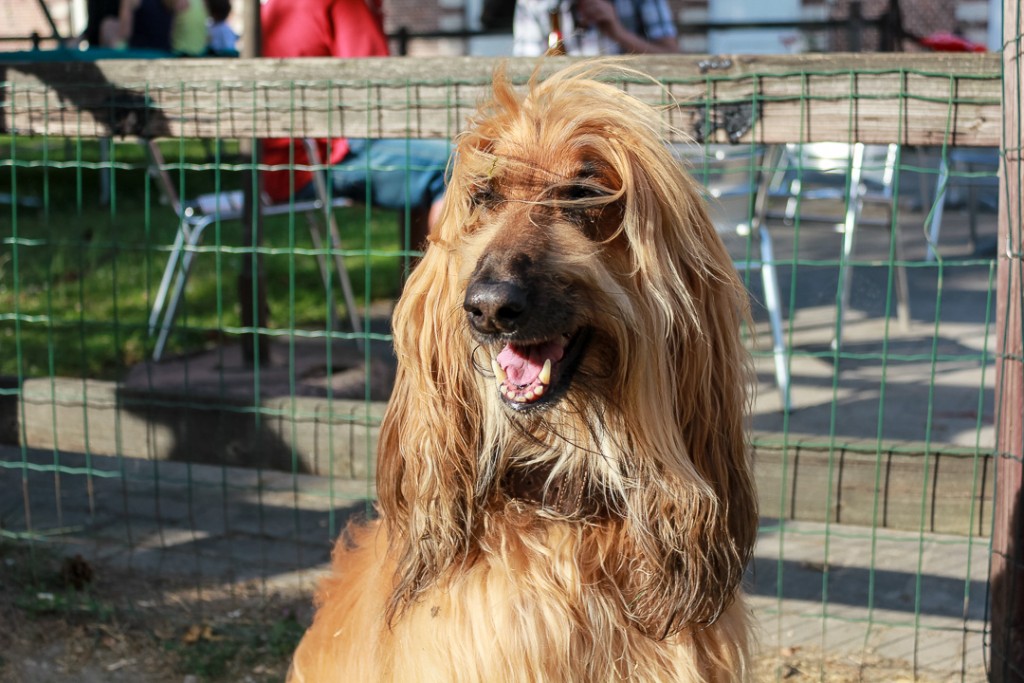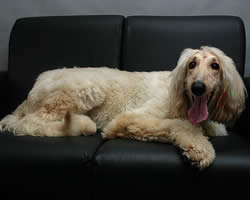Afghan Hound Dog Breed Information, Also known as Sage Baluchi or Tazi
| Size: |  |
| Trainability: |  |
| Level of Energy: |  |
| Exercise Needs: |  |
| Level of Affection: |  |
| Climate Tolerance: |  |
| Good With Children: |  |
| Tolerance of Animals: |  |
| Suitable as Watch Dog: |  |
Afghan Hound Dog – Just The Facts
- AKC Popularity: 95
- AKC Breed Group: Hound
- Size of Male: 50-60 lbs., 25-27 in.
- Size of Female: 50-60 lbs., 25-27 in.
- Color: All colors are permissible; color combinations are pleasing in the breed
- Average Lifespan: 12-14 years
- Breed Origin: Afghanistan
- Purpose: Sighthound, hunting dog
Do you own this Dog breed?
Please tell us about it in the form at the bottom of this page.
Need a good Puppy Name?
Visit our Puppy Names page for 1000s of top dog names.
General Description
The Afghan Hound is one of the oldest of all dog breeds. These tall, rangy sighthounds have been in existence for several thousand years, according to DNA analysis. Afghans may be the aristocrats of the dog world.
With long, silky hair they give a regal appearance. They can be aloof and independent and they aren’t known for taking orders. They can be playful and clownish at times. They are hard to train but generally gentle dogs. Afghans can make good family pets, provided you are willing to do a lot of grooming and give them lots of exercise.
Origin and History
The exact origin of the Afghan Hound can only be surmised. They seem to have developed in the mountainous regions of Afghanistan and the desert areas south of there. There is no doubt that they are an ancient breed, as confirmed by DNA analysis, which points to the fact that they may be the oldest of all sighthounds.
Two distinct types of the Afghan dog breeed evolved in these areas: the dogs of the southern and western areas are rangy, lighter in color and have a sparser coat. The dogs of the northern mountain regions are more compact, darker and have more coat.
Afghan dogs are coursing hounds, hunting their prey by sight. They hunted either singly, in pairs or in packs. They were used to hunt hare, wolves, jackals, marmots and snow leopards. The dogs have great strength, speed and stamina.
They were first brought to Europe in the 19th century. The Afghan Hounds we have today in the West are descendants of Afghans brought to Scotland in 1920.
Afghan Hound Temperament
In many ways the Afghan Hound epitomizes the sighthound temperament. They are very independent dogs. Their role as hunters required them to work and think for themselves, without human interference. They can be just as intelligent as any other breed of dog. However, dog training can be difficult since they usually don’t see any need to follow human commands.
They are often called “aloof.” An Afghan dog may lie down in the same room with you and not feel any need to come and cuddle. They may not be the most affectionate breed of dog. Instead, they are usually quite regal and agree to honor you with their companionship.
They may seem a little like a cat in some ways. However, Afghan dogs can also be very playful and clownish at times, especially as puppies and young dogs. No puppies play more wildly than Afghans.
Otherwise, Afghan dogs generally make good pets. They are usually gentle and good-natured. They don’t bark excessively. They are not known for chewing or digging problems. They usually get along well with other dogs.
WARNING: If you have cats or other small pets, you will need to be very careful. Your Afghan is likely to consider them prey. Afghans usually get along well with children, especially older children.
Care, Grooming, Diet & Exercise
Living Environment – The Afghan Hound can do surprisingly well as an apartment dog, as long as they get plenty of daily exercise. They are moderately active indoors but don’t feel the need to follow you from room to room. They do enjoy having a yard of their own.
If they do have their own yard, make sure it’s securely fenced. Afghan dogs are very athletic and can jump fences if they feel inclined.
Grooming – Afghans require plenty of regular grooming. You shouldn’t get an Afghan dog unless you are prepared to devote time to their coat since it can become matted and need to be shaved down without proper care.
Afghans kept as pets need to be bathed a couple of times per month and their coats should be thoroughly conditioned. Make sure that you comb out the coat when it’s wet. Blow drying is recommended, which can take some time.
A puppy’s fluffy coat will need to have the saddle stripped to reveal the dog’s sleek back. If you are in doubt about how to care for your Afghan dog’s coat you should talk to a breeder or a professional groomer who is familiar with the breed.
Diet & Exercise – The Afghan Hound has normal dietary requirements. However, be aware that many people will believe that your dog is too skinny even when he is in proper weight. You should ignore them and not overfeed your dog. Sighthounds are supposed to be lean and should not be overweight or obese.
Afghans are also prone to bloat, so it’s best to feed them 2-3 small meals per day instead of one large meal. They also need plenty of daily exercise. You will probably not be able to give your Afghan dog enough exercise by walking. These dogs really need a chance to run. Find safe areas where your dog can run off-leash. But make sure the area is enclosed. If your Afghan finds prey to chase he will not come back when you call him.
Health – Afghan Hounds are generally considered a healthy breed and they have a relatively long life. However, they can suffer from dog allergies and cancers. Like other sighthounds, this dog breed can have problems with anesthesia. You should make sure your veterinarian is aware of this issue.
Chylothorax can also be a problem in the breed. If you are interested in getting an Afghan Hound you should talk to a breeder about possible health problems in the breed.
Afghan Hound Trainability
With regard to dog training, the Afghan Hound can be very difficult to train because of his independence. You will need to be very patient and persistent if you set out to train an Afghan Hound.
These dogs tend to be on the sensitive side so it’s best to train with positive reinforcement techniques (praise, reward). If you use positive dog training methods you will have your best chance of success.
Other images:
Do you own this dog breed?
Please tell us about your experience with a particular dog breed, and upload a picture if you have one!
Return to AKC List of Dog Breeds ranked by Popularity Return from Afghan Hound back to Alphabetical List of Dogs Breeds page Return to Dogs and Dog Advice home page



